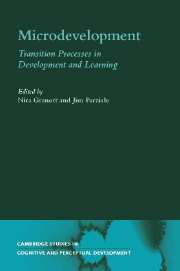Book contents
- Frontmatter
- Contents
- List of figures
- List of tables
- List of contributors
- Microdevelopment: A process-oriented perspective for studying development and learning
- Part I Variability
- Part II Transition mechanisms
- 4 A multi-component system that constructs knowledge: Insights from microgenetic study
- 5 Bridging to the unknown: A transition mechanism in learning and development
- 6 Observing the dynamics of construction: Children building bridges and new ideas
- Part III Micro- and macrodevelopment
- Part IV Context
- Author index
- Subject index
- References
5 - Bridging to the unknown: A transition mechanism in learning and development
Published online by Cambridge University Press: 22 September 2009
- Frontmatter
- Contents
- List of figures
- List of tables
- List of contributors
- Microdevelopment: A process-oriented perspective for studying development and learning
- Part I Variability
- Part II Transition mechanisms
- 4 A multi-component system that constructs knowledge: Insights from microgenetic study
- 5 Bridging to the unknown: A transition mechanism in learning and development
- 6 Observing the dynamics of construction: Children building bridges and new ideas
- Part III Micro- and macrodevelopment
- Part IV Context
- Author index
- Subject index
- References
Summary
How are new abilities created out of existing, less advanced abilities? This question has puzzled researchers for centuries. Various answers have been suggested, yet the mechanisms underlying development have remained enigmatic. In this chapter, we analyze and demonstrate a process called bridging that provides a specific answer to the fundamental question of how more powerful structures can be achieved on the basis of less powerful ones.
Bridging is a process of leaping into the unknown by inserting marker shells that indicate targets for development and learning (Granott, 1993a, 1994, Granott & Parziale, 1996). The marker shells serve as place-holders that people use to direct their own learning and development toward achieving these targets. A shell is like a formula in mathematics, in which the variables represent an unknown whose values can be later defined. Bridging operates as an attractor in dynamic systems and pulls development toward more advanced, relatively stable levels. People use bridging by creating partially defined shells that mark future skills to be constructed at higher knowledge levels. The shells do not contain the relevant knowledge yet, but they outline it. The shells serve as scaffolds that guide the construction of new knowledge by providing a perspective for processing new experiences. A bridging shell serves as a dynamic attractor after its initial emergence in real-time activities within context.
We suggest that bridging is a transition mechanism that people use spontaneously at a wide range of ages.
- Type
- Chapter
- Information
- MicrodevelopmentTransition Processes in Development and Learning, pp. 131 - 156Publisher: Cambridge University PressPrint publication year: 2002
References
- 29
- Cited by



